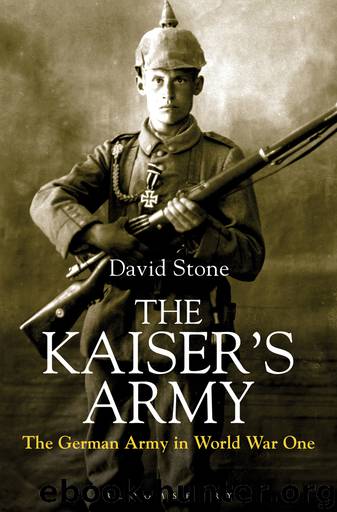The Kaiser's Army by David Stone

Author:David Stone [Stone, David]
Language: eng
Format: epub
Publisher: Bloomsbury Publishing
5. ARMOURED FIGHTING VEHICLE TROOPS
The army’s armoured fighting vehicle troops did not comprise a separate combat arm, and their organization’s existence during the war was relatively short-lived; nevertheless, they were potentially a very important addition to the army’s offensive capability. Their late development and consequent appearance on the battlefield only late in the war represented a missed opportunity on the part of the army. In light of its often innovative approach to the business of war, the general staff’s failure to develop and employ armoured vehicles – but specifically the vehicle known as the tank – was remarkable. As early as 1908, three experimental armoured cars equipped with machine-guns had appeared at the major army manoeuvres of that year, but on that occasion nobody could decide how to use or deploy them. Later, in 1911, an Oberleutnant Burstyn of the Austrian army railway troops provided the Prussian war ministry with his plans for an armoured, machine-gun mounted, all-terrain vehicle fitted with caterpillar tracks – truly a tank in embryo – but the military authorities failed to pursue the concept even to the experimental stage. Consequently, the conceptual and developmental initiative lay with the Allies and remained so throughout the war.
Although the army had experienced an Allied attack by tanks – albeit on a relatively small scale – on the Somme on 13 September 1916, a directive by the high command for the head of the field motorized service (Allgemeines Kriegsdepartment, 7. Abteilung Verkehrswesen)210 to take forward the construction of armoured combat vehicles resulted in little substantive progress. This was in part due to an uncharacteristic degree of inertia and lack of vision on the part of the general staff but also to more pragmatic considerations and factors. The first prototype tank was produced and tested on 30 April 1917 (at which stage it was judged not to have met the requirements set by the high command) with a full-size mock-up completed and demonstrated in Mainz in May, a pre-production model produced in September and a first production model of what was designated the A7V in October. However, its production in significant quantities was by then virtually unachievable. As Ludendorff acknowledged, in order to focus upon tank production the army would have had to forgo other capabilities, industrial workers would have had to be reallocated from other war production work, while any spare capacity in the industrial labour force would in any case have had to be drafted into the army by that stage of the war.211 Shortages of raw materials and skilled workers in Germany, and of general-purpose transport within the army, meant that industrial production was necessarily prioritized to favour submarines, railways, aircraft, munitions, artillery and motorized transport to enable the movement of reserves. It should also be remembered that the army on the Western Front was generally committed to a defensive war by late 1916, pending a Russian collapse and redeployment of divisions from the Eastern Front to the Western Front. With no viable model of German tank
Download
This site does not store any files on its server. We only index and link to content provided by other sites. Please contact the content providers to delete copyright contents if any and email us, we'll remove relevant links or contents immediately.
| Africa | Americas |
| Arctic & Antarctica | Asia |
| Australia & Oceania | Europe |
| Middle East | Russia |
| United States | World |
| Ancient Civilizations | Military |
| Historical Study & Educational Resources |
The Guns of August by Barbara Wertheim Tuchman(882)
Uniforms of the German Solider by Alejandro M. de Quesada(828)
A World Undone by G. J. Meyer(815)
The Treaty of Versailles by Michael S. Neiberg(784)
I by Anonymous(761)
Catastrophe 1914: Europe Goes to War by Max Hastings(759)
The-Odyssey by Unknown(757)
The Ghost Ships of Archangel by William Geroux(729)
They Called it Passchendaele by Lyn Macdonald(670)
8.4 by Peter Hernon(654)
1914-1918: The History of the First World War by David Stevenson(653)
The Oxford Illustrated History of the First World War by Hew Strachan(632)
Goodbye to All That (Penguin Modern Classics)(611)
August 1914 by Bruno Cabanes(595)
Seven Pillars of Wisdom : A Triumph (9780804170826) by Lawrence T. E(587)
First World War For Dummies by Seán Lang(578)
Animals In War by Jilly Cooper(572)
Defending Gallipoli by Harvey Broadbent(568)
Russia Against Napoleon: The True Story of the Campaigns of War and Peace by Dominic Lieven(566)
